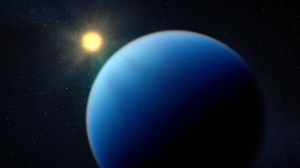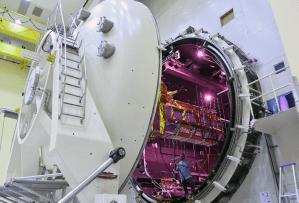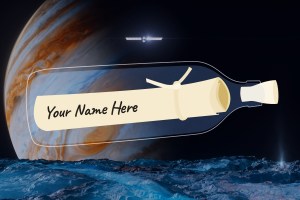NASA’s Cold Atom Lab Sets Stage for Quantum Chemistry in Space
The remotely operated facility aboard the International Space Station has created another tool that researchers can use to probe the fundamental nature of the world around us. For the first time in space, scientists have produced a quantum gas containing two types of atoms. Accomplished with NASA’s Cold Atom Laboratory aboard the International Space Station, […]

7 min read
NASA’s Cold Atom Lab Sets Stage for Quantum Chemistry in Space
The remotely operated facility aboard the International Space Station has created another tool that researchers can use to probe the fundamental nature of the world around us.
For the first time in space, scientists have produced a quantum gas containing two types of atoms. Accomplished with NASA’s Cold Atom Laboratory aboard the International Space Station, the achievement marks another step toward bringing quantum technologies currently available only on Earth into space.
Quantum tools are already used in everything from cellphones to GPS to medical devices. In the future, they could be used to enhance the study of planets, including our own, and help solve mysteries of the universe while deepening our understanding of the fundamental laws of nature.
The new work, performed remotely by scientists on Earth, is described in the Nov. 16 issue of the journal Nature.
With this new capability, the Cold Atom Lab can now study not only the quantum properties of individual atoms, but also quantum chemistry, which focuses on how different types of atoms interact and combine with each other in a quantum state. Researchers will be able to conduct a wider range of experiments with Cold Atom Lab and learn more about the nuances of performing them in microgravity. That knowledge will be essential for harnessing the one-of-a-kind facility to develop new space-based quantum technologies.
Quantum Chemistry
The physical world around us depends on atoms and molecules staying bound together according to an established set of rules. But different rules can dominate or weaken depending on the environment the atoms and molecules are in – like microgravity. Scientists using the Cold Atom Lab are exploring scenarios where the quantum nature of atoms dominates their behaviors. For example, instead of acting like solid billiard balls, the atoms and molecules behave more like waves.
In one of those scenarios, the atoms in two- or three-atom molecules can remain bound together but grow increasingly far apart, almost as though the molecules are getting fluffy. To study these states, scientists first need to slow the atoms down. They do this by cooling them to fractions of a degree above the lowest temperature matter can reach, far colder than anything found in the natural universe: absolute zero, or minus 459 degrees Fahrenheit (minus 273 degrees Celsius).
Physicists have created these fluffy molecules in cold atom experiments on the ground, but they are extremely fragile and either break apart quickly or collapse back down to a normal molecular state. For that reason, enlarged molecules with three atoms have never been directly imaged. In the microgravity of the space station, the fragile molecules can exist for longer and potentially get larger, so physicists are excited to start experimenting with the Cold Atom Lab’s new capability.
These types of molecules likely don’t occur in nature, but it’s possible they could be used to make sensitive detectors that can reveal subtle changes in the strength of a magnetic field, for example, or any of the other disturbances that cause them to break apart or collapse.
“What we’re doing with cold atom science in general is looking for and learning about new tools that nature gives us,” said Jason Williams of NASA’s Jet Propulsion Laboratory in Southern California, project scientist for the Cold Atom Lab and a co-author on the new study. “It’s like we’ve discovered a hammer and we’re just starting to investigate all the ways we could use it.”
A Modern Mystery
One possible way of using a quantum gas with two types of atoms would be to test something called the equivalence principle, which holds that gravity affects all objects the same way regardless of their mass. It’s a principle that many physics teachers will demonstrate by putting a feather and a hammer in a sealed vacuum chamber and showing that, in the absence of air friction, the two fall at the same rate. In 1971, Apollo 15 astronaut David Scott did this experiment on the Moon’s surface without the need for a vacuum chamber.
Using an instrument called an atom interferometer, scientists have already run experiments on Earth to see if the equivalence principle holds true at atomic scales. Using a quantum gas with two types of atoms and an interferometer in the microgravity of the space station, they could test the principle with more precision than what’s possible on Earth. Doing so, they might learn whether there’s a point where gravity doesn’t treat all matter equally, indicating Albert Einstein’s general theory of relativity contains a small error that could have big implications.
The equivalence principle is part of the general theory of relativity, the backbone of modern gravitational physics, which describes how large objects, like planets and galaxies, behave. But a major mystery in modern physics is why the laws of gravity don’t seem to match up with the laws of quantum physics, which describe the behaviors of small objects, like atoms. The laws of both fields have proven to be correct again and again in their respective size realms, but physicists have been unable to unite them into a single description of the universe as a whole.
Looking for features of gravity not explained by Einstein’s theory is one way to search for a means of unification.
Better Sensors
Scientists already have ideas to go beyond testing fundamental physics in microgravity inside the Cold Atom Lab. They have also proposed space-based experiments that could use a two-atom interferometer and quantum gases to measure gravity with high precision in order to learn about the nature of dark energy, the mysterious driver behind the accelerating expansion of the universe. What they learn could lead to the development of precision sensors for a wide range of applications.
The quality of those sensors will depend on how well scientists understand the behavior of these atoms in microgravity, including how those atoms interact with each other. The introduction of tools to control the atoms, like magnetic fields, can make them repel each other like oil and water or stick together like honey. Understanding those interactions is a key goal of the Cold Atom Lab.
More About the Mission
A division of Caltech in Pasadena, JPL designed and built Cold Atom Lab, which is sponsored by the Biological and Physical Sciences (BPS) division of NASA’s Science Mission Directorate at the agency’s headquarters in Washington. BPS pioneers scientific discovery and enables exploration by using space environments to conduct investigations not possible on Earth. Studying biological and physical phenomena under extreme conditions allows researchers to advance the fundamental scientific knowledge required to go farther and stay longer in space, while also benefitting life on Earth.
To learn more about Cold Atom Lab, go here:
https://coldatomlab.jpl.nasa.gov/
News Media Contact
Calla Cofield
Jet Propulsion Laboratory, Pasadena, Calif.
626-808-2469
calla.e.cofield@jpl.nasa.gov
2023-170
Share
Details
Related Terms
Discover Related Topics












































